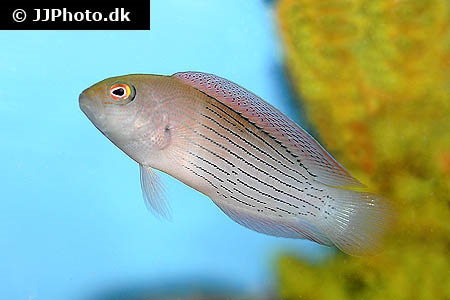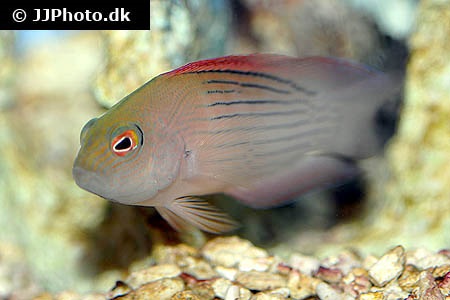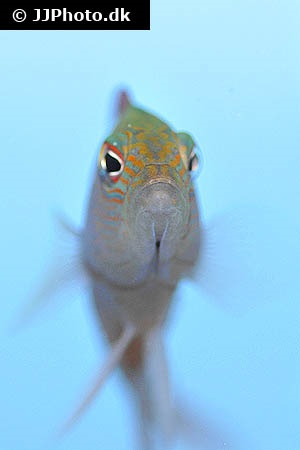Labracinus cyclophthalmus
| Latin name | Labracinus cyclophthalmus - (Müller & Troschel, 1849) |
|---|---|
| Local name | Sailfin dottyback |
| Family | Pseudochromidae - Labracinus |
| Origin | East Indian Ocean, Australia, Japan, Indonesia, New Zealand, Central/West Pacific |
| Max length | 23 cm (9.1") |
| Minimum volume |
300 l (79 gal) |
|---|---|
| Hardiness |
Hardy |
| Suitable for aquarium |
Suitable with care |
| Reef safe |
Reef safe with caution |
| Aggressiveness | Aggressive towards other species |
| Recommended |
Fish Larger crustaceans (Shrimp, crabs...) Small crustaceans (Krill, mysis, artemia...) Zooplankton (Cyclops, pods...) |
|---|
This species is known to jump out of open aquaria.
This spicies might be a threat to smaller fishes.
This species can be a threat towards small crustaceans, e.g. small shrimp.
This species can be extremely aggressive towards other fish.
Be careful when keeping these fish together with peaceful or docile species. Regular feeding, plenty of hiding places and a lot of space can alleviate aggressive behavior to some degree.
They can live as a pair provided they are introduced simultaneously.
This species needs good hiding places, for example, between live rocks.
This species can change gender from female to male.
When a male is needed, a female changes sex and takes on the role.
This species can be bred in captivity, one can therefore consider asking your local fish store for a captive bred specimen.
Dottybacks (Pseudochromidae) are often very colourful, rather hardy and relatively small, typically under 4 inch (10 cm). These fish can be distinguished from other fish by looking at the shape of the eye, see for example the picture of this: Hawkfish, Surgeonfish, Rabbitfish, Angelfish, Triggerfish, Clown/ Damselfish or Pufferfish.
Dottybacks will compete for food with other fish which eat zooplankton off the rocks. Mandarinfish and similar species can find it difficult to get enough food if kept together with Dottybacks.
One could consider the Gramma species, if one wishes a similar fish which is more peaceful.
| Aquarium trade | Yes |
|---|---|
| Distribution | Western Pacific: widely distributed throughout the Indo-Malayan Archipelago, from southern Japan, south to the Northwest Shelf of Australia, and east to New Ireland, Papua New Guinea. |
| English common names |
Darkstriped dottyback Firetail dottyback Giant dottyback |
Henry C. Schultz. 2002. The Dottybacks - Reefkeeping - (English)
Scott W. Michael. 2001. Basslets, Dottybacks & Hawkfishes: v. 2 (Reef Fishes) - TFH Publications / Microcosm Ltd. - (English)
Bob Fenner. The Dottybacks, Family Pseudochromidae - Wet Web Media - (English)
Collection of links to additional information - Wet Web Media - (English)




